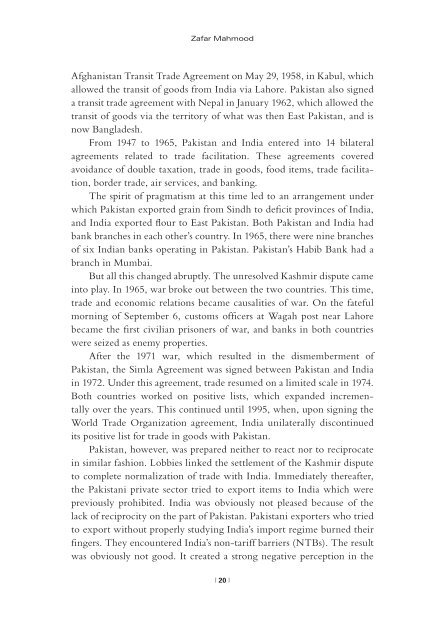Create successful ePaper yourself
Turn your PDF publications into a flip-book with our unique Google optimized e-Paper software.
Zafar Mahmood<br />
Afghanistan Transit <strong>Trade</strong> Agreement on May 29, 1958, in Kabul, which<br />
allowed the transit of goods from <strong>India</strong> via Lahore. <strong>Pakistan</strong> also signed<br />
a transit trade agreement with Nepal in January 1962, which allowed the<br />
transit of goods via the territory of what was then East <strong>Pakistan</strong>, and is<br />
now Bangladesh.<br />
From 1947 to 1965, <strong>Pakistan</strong> and <strong>India</strong> entered into 14 bilateral<br />
agreements related to trade facilitation. These agreements covered<br />
avoidance of double taxation, trade in goods, food items, trade facilitation,<br />
border trade, air services, and banking.<br />
The spirit of pragmatism at this time led to an arrangement under<br />
which <strong>Pakistan</strong> exported grain from Sindh to deficit provinces of <strong>India</strong>,<br />
and <strong>India</strong> exported flour to East <strong>Pakistan</strong>. Both <strong>Pakistan</strong> and <strong>India</strong> had<br />
bank branches in each other’s country. In 1965, there were nine branches<br />
of six <strong>India</strong>n banks operating in <strong>Pakistan</strong>. <strong>Pakistan</strong>’s Habib Bank had a<br />
branch in Mumbai.<br />
But all this changed abruptly. The unresolved Kashmir dispute came<br />
into play. In 1965, war broke out between the two countries. This time,<br />
trade and economic relations became causalities of war. On the fateful<br />
morning of September 6, customs officers at Wagah post near Lahore<br />
became the first civilian prisoners of war, and banks in both countries<br />
were seized as enemy properties.<br />
After the 1971 war, which resulted in the dismemberment of<br />
<strong>Pakistan</strong>, the Simla Agreement was signed between <strong>Pakistan</strong> and <strong>India</strong><br />
in 1972. Under this agreement, trade resumed on a limited scale in 1974.<br />
Both countries worked on positive lists, which expanded incrementally<br />
over the years. This continued until 1995, when, upon signing the<br />
World <strong>Trade</strong> Organization agreement, <strong>India</strong> unilaterally discontinued<br />
its positive list for trade in goods with <strong>Pakistan</strong>.<br />
<strong>Pakistan</strong>, however, was prepared neither to react nor to reciprocate<br />
in similar fashion. Lobbies linked the settlement of the Kashmir dispute<br />
to complete normalization of trade with <strong>India</strong>. Immediately thereafter,<br />
the <strong>Pakistan</strong>i private sector tried to export items to <strong>India</strong> which were<br />
previously prohibited. <strong>India</strong> was obviously not pleased because of the<br />
lack of reciprocity on the part of <strong>Pakistan</strong>. <strong>Pakistan</strong>i exporters who tried<br />
to export without properly studying <strong>India</strong>’s import regime burned their<br />
fingers. They encountered <strong>India</strong>’s non-tariff barriers (NTBs). The result<br />
was obviously not good. It created a strong negative perception in the<br />
| 20 |


